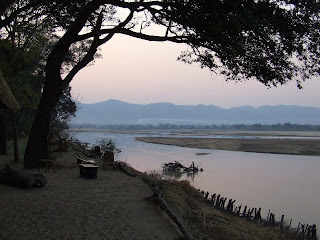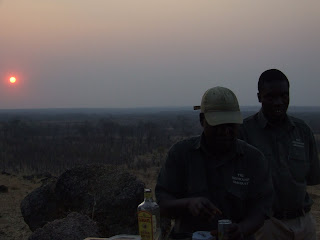So I'm now into my second month out here in the South
Luangwa Valley. The last few weeks have been really exciting, and even though I've been not as efficient as I hoped at updating weekly pictures and tales of adventure, I'll fill you in with some of the best bits here.
As well as my night time encounter with the 'snake', there have been a whole host of wildlife encounters over the past few weeks: Some have been with bizarre and fascinating animals, some have been unwanted guests, and some have been close shaves. The 'close shave' being about a week ago, when I was walking back to my room by torch light and noticed two large green eyes watching me from about 15 meters away. On realising that I was being sized up by a lion, I had to employ every muscle in my body not to commit the cardinal sin of running away and thus triggering the 'prey' switch in the lion's mind. Slowly I edged my way backwards to the safety of the lodge to find a group of the night watch-men to scare off the predator in the darkness.
Below is an amazing little flap-necked
chameleon that James, one of the walking safari guides here, caught for me one evening. We named him George, and it happily sat on my hand for about 15 minutes, swiveling its turret-like eyes and making numerous failed attempts to bite me in slow motion - definitely the coolest animal I know.

This was a rather less welcome animal encounter; a huge centipede that made its way across my pillow one evening. As well as being a truly ugly beast, these centipedes also pack a really nasty sting, and so I made sure that he was thrown well away from my room before I tried to sleep that night.

The annual carmine bee-eater migration has made its way to the valley, and at various places along the
Luangwa River bank, these beautiful red and green birds can be seen nesting in their thousands. I've spent a few evenings filming the colony; flying in and out of their holes, swooping and catching flying insects above my head. As usual with the great wildlife spectacles that I get to film here, my time is taken up with my video camera and so I seldom have great pictures of what I've been filming - this is a picture of one of the carmine bee-eaters that I took on one of our evening game-drives to give you an idea of what this gorgeous species looks like.

South
Luangwa National Park is reputed to have some tamed warthogs. Two brother warthogs called Rocky and Robert were apparently hand-reared 10 years ago or so, and then released into the wilds of the park. The legend goes, that Rocky died a few years ago, but that a very 'friendly' warthog, that is often seen near
Mfuwe Waffa (the dry lagoon next to
Mfuwe Lodge), is believed to be Robert. I took myself off for a short drive a few days ago and met what I think was the infamous Robert; he seemed to be compelled to walk up to me (most warthogs run away when you come within 30 meters of them), stopped right next to the car, and just looked up at me longingly... He hung about long enough for me to take some great pics of him together with a red-billed ox pecker who came to join in the action. Long live Robert!

The park is mostly comprised of
Mopane woodland (either stunted or really tall, scrubby, match stick like trees with green/yellow leaves), but there are also a few huge baobab trees dotted about the place. These distinctive 'upside down trees' can grow to a massive diameter of about 12 meters in some cases, and were used hundreds of years ago by local tribes who hollowed them out into the ultimate 'tree-house'.

As I have an interest in all things biological, I've made it my goal to learn as much as possible about the plants, animals, trees, birds, landscapes, people and language of this region, whilst I'm here in the South
Luangwa Valley. I've recently become a bit of a 'tree geek' and spent about 30 minutes the other day with one of the guides, trying to work out the reproductive
strategy of the Sausage-tree. From what we worked out, these amazing red flowers hold the male reproductive organs (
producing the pollen), and the long thin, small green pod that remains on the tree when the flowers fall off, contains the female organs - science aside, these are beautiful flowers, and they smell strangely edible!?





















































